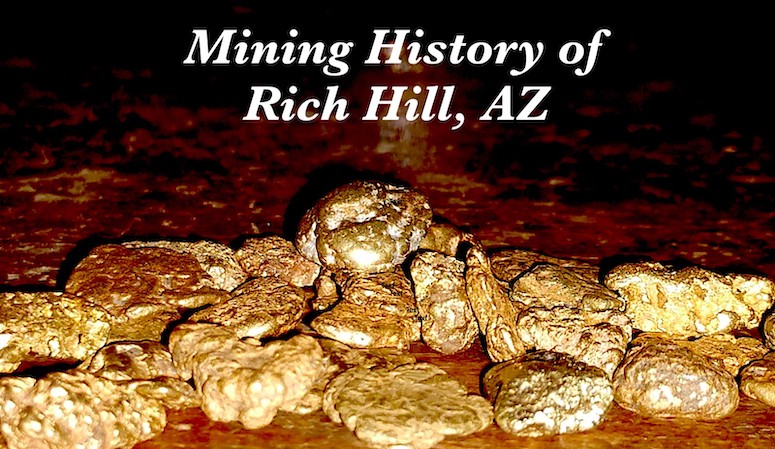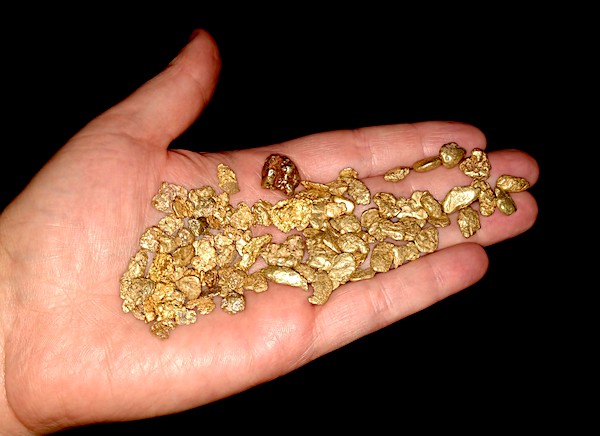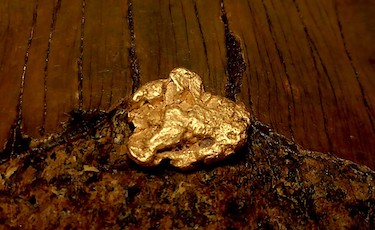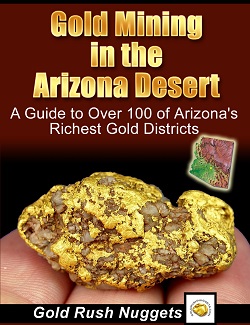
Rich Hill is aptly named. Located in Yavapai County, it has a long and rich gold mining history. The first prospectors in the area showed up in the 1860s, and it quickly drew attention from miners throughout the region.
Early Gold Discoveries
A prospector named Pauline Weaver discovered gold in this area in 1863. It took no time at all for a mining camp to be established. By the next year, gold had been found on Rich Hill and miners really took notice.
Coarse free-milling gold was abundant at Rich Hill. This type of gold was easily extractable using simple mining methods. This was critically important for Arizona miners, who consistently had to struggle with a severe lack of water.
As a result, the area quickly became a hub for small-scale miners who used picks, shovels, and pans to extract the precious metal from the ground.
A Full-On Mining Camp
By the end of the decade, Rich Hill had become one of the most productive gold mining areas in all of Arizona. At its peak, the area was home to over 5,000 miners, and it produced over $2 million worth of gold in just a few years.
Nearly all of the gulches and dry washed around Rich Hill contained gold. Men would dig down to bedrock and find coarse gold nuggets sitting down at bedrock. Many of these nuggets were large, and in the early days it was not uncommon to find 1+ ounce gold nuggets on a claim.
Get this Highly Recommended New Book:

The Gold Prospector’s Field Guide:
A Modern Miner’s Handbook for Successfully Finding Gold
The Richest Areas near Rich Hill
Weaver Creek was a drainages that was extensively worked. Miles and miles of these stream beds were dug up and drywashed, a method that would separate gold from light gravel without the need for water. It was a hot and dusty way to make a living, but it worked well on the rich placers.
One the west side of Rich Hill is Antelope Creek, another rich drainage for gold miners. The Lost Dutchman’s Mining Association has ground in Stanton right along the creek and lots of claims that prospector still hunt for gold even today.

There are still nice chunky gold nuggets like this being found around Rich Hill and throughout Yavapai County. Of course smaller gold is more abundant, but nice nuggets weighing several grams are not unheard of even today. Metal detecting the washes and gulches can be productive.
The gold at the Octave Mine was found in the form of free-milling gold, which made it easy to extract using simple mining methods. This was an underground mine, and it was known for producing high-grade gold ore. The rich ores were extensive and highly productive for many years.
The Octave Mine continued to produce gold on and off for several decades, with production declining in the 1930s as the most accessible gold deposits were exhausted. Operations shut down during World War 2, as did most precious metal mines during that time. In the 1950s, the mine was briefly reopened, but production was once again short-lived. It produced around 80,000 ounces of gold.
Visit this area today and you will see lots of old diggings from old mining operations.

It can be worthwhile to search these areas with your metal detector. Coarse gold specimens and nice gold nuggets have come from the Rich Hill area. Historically, many multi-ounce nuggets have been found here.
At the top of Rich Hill was an area that would become known as the Potato Patch. Up high on the hill sits one of Arizona’s most famous gold mines. This was where some incredibly large nuggets were recovered. Those early miners claimed the nuggets were as big as potatoes. The area was worked for many years.
Despite its early success, gold mining on Rich Hill began to decline in the late 1870s as the most accessible gold deposits were exhausted. The shallow areas were all dug down to bedrock and worked until most of the gold was gone. After a decade of mining the area, it was simply not profitable for small-scale miners to work most areas.
Mining Now
Today, Rich Hill is still home to small-scale mining operations, and it remains a popular destination for prospectors.
A word of warning… this area is heavily claimed and you are unlikely to find an area to prospect without doing extensive research. Even then, I doubt that you will find any unclaimed ground around Rich Hill.
For most prospectors, the best opportunities come from joining one of the local clubs in the area. There are several club claims that you can join that will give you access to many acres of gold bearing ground.
Even though miners have been digging gold here for centuries, the rugged, rocky nature of the area around Rich Hill makes it a challenging area to mine effectively. There is still gold here, including big nuggets.
A lot of mining operations are using heavy equipment to move boulders out of the way and dig down to where the gold is. It’s slow going, but they are still finding gold!
Next: Gold in Oatman! Riches in Arizona’s Mojave Desert
Get the eBook: Start Finding Gold in Arizona: A Guide to Over 100 of Arizona’s Richest Gold Districts

